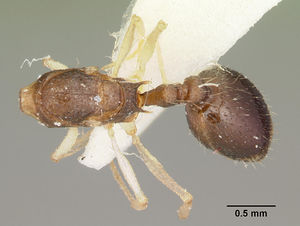Temnothorax liviae
| Temnothorax liviae | |
|---|---|

| |
| Scientific classification | |
| Kingdom: | Animalia |
| Phylum: | Arthropoda |
| Class: | Insecta |
| Order: | Hymenoptera |
| Family: | Formicidae |
| Subfamily: | Myrmicinae |
| Tribe: | Crematogastrini |
| Genus: | Temnothorax |
| Species: | T. liviae |
| Binomial name | |
| Temnothorax liviae (Agosti & Collingwood, 2011) | |
Specimens of Temnothorax liviae were collected in a pitfall trap from Baynunah, a sandy desert in United Arab Emirates (UAE). The species is known only from its type locality (Sharaf et al., 2017).
Identification
Collingwood et al. (2011) - The general appearance is somewhat like Temnothorax cenatus but the species differs in the relatively larger eyes, longer coarser propodeal spines and the less angulate petiole. It is a larger species than the known North African or Iberian large-eyed desert species (Temnothorax laurae Emery, 1884 species group) and has a wider head, distinct longitudinal sculpture on the dorsum of the head, and fewer erect hairs on head and alitrunk than Temnothorax arenarius. The queen has features similar to the worker but the mesonotum is less coarsely sculptured. Worker specimens taken from under stones in the Buraimi area in the vicinity of trees are smaller than the holotype (TL 2.9-3.0) but have similar body structure and colour.
Keys including this Species
Distribution
Latitudinal Distribution Pattern
Latitudinal Range: 23.8333° to 23.66666667°.
| North Temperate |
North Subtropical |
Tropical | South Subtropical |
South Temperate |
- Source: AntMaps
Distribution based on Regional Taxon Lists
Afrotropical Region: United Arab Emirates (type locality).
Distribution based on AntMaps
Distribution based on AntWeb specimens
Check data from AntWeb
Countries Occupied
| Number of countries occupied by this species based on AntWiki Regional Taxon Lists. In general, fewer countries occupied indicates a narrower range, while more countries indicates a more widespread species. |

|
Estimated Abundance
| Relative abundance based on number of AntMaps records per species (this species within the purple bar). Fewer records (to the left) indicates a less abundant/encountered species while more records (to the right) indicates more abundant/encountered species. |

|
Biology
Castes
Queen
Images from AntWeb
   
| |
| Queen (alate/dealate). Specimen code casent0102699. Photographer April Nobile, uploaded by California Academy of Sciences. | Owned by CAS, San Francisco, CA, USA. |
Nomenclature
The following information is derived from Barry Bolton's Online Catalogue of the Ants of the World.
- liviae. Leptothorax liviae Agosti & Collingwood, in Collingwood, et al. 2011: 430, pl. 44-46, figs. 36, 37 (w.q.) UNITED ARAB EMIRATES.
- Combination in Temnothorax: Sharaf et al., 2017: 6.
Unless otherwise noted the text for the remainder of this section is reported from the publication that includes the original description.
Description
Worker
Holotype. Total length 4.2; head length 1.0 I; head width 0.87; scape length 0.91; cephalic index 86.1; scape index 104.6; eye length/head width 0.46. Mandibles weakly striate, head strongly striate, frontal triangle clear; alitrunk dorsum and petiole strongly striate, postpetiole striae restricted to dorsum; gaster shining. Frontal laminae prominent and expanded anterolaterally; eyes enormous, nearly half head length; scape relatively long, slightly over-reaching occipital border. Alitrunk dorsal outline with distinct metanotal furrow, but impression shallow. Propodeal spines long and pointed; petiole profile with rounded subangulate dorsum and blunt anterolateral tooth. Dorsal hairs rather short, ventral head hairs long and curved but not crowded. Gaster with short oblique hairs over whole surface. Colour evenly light brown with pale legs and antennae.
Queen
Sharaf & Akbar (2017) - EL 0.35; FRS 0.27; HFL 0.85; HFW 0.14; HL 1.01; HW 0.75; IOD 0.67; OMD 0.21; IOcD 0.19; PPTL 0.29; PPTH 0.27; PPTW 0.45; PTL 0.50; PTH 0.40; PTW 0.28; SPST 0.32; PW 0.57; SL 0.87; WL 1.24; CI 74; OI 46; FI 113; PI 49; PSLI 31; SI 80 (n=1).
Head and body. Similar to the workers from the same colony but larger, with thicker body, especially mesosoma and gaster. Ocelli present, prominent. Pilosity is much more prominent compared to the workers.
Type Material
Holotype: worker, United Arab Emirates, Baynunah sand desert [23°40'N 53°00'E], ii-iii.1995, in pitfall trap. leg. B. Tigar & C.A. Collingwood (Naturhistorisches Museum, Basel). Paratypes: 1 worker, same locality as holotype but 3.xii.1994. coll. B. Tigar. 1 worker, Buraimi, 16.iii.1995, leg. B. Tigar & CAC. 1worker, al-Ain, 13.iii.2005, California Academy of Sciences.
Etymology
This new species is dedicated to Livia Leu Agosti, wife of Donat Agosti.
References
- Borowiec, L. 2014. Catalogue of ants of Europe, the Mediterranean Basin and adjacent regions (Hymenoptera: Formicidae). Genus (Wroclaw) 25(1-2): 1-340.
- Collingwood, C.A., Agosti, D., Sharaf, M.R., van Harten, A. 2011. Order Hymenoptera, family Formicidae. Arthropod fauna of the UAE 4: 405-474.
- Sharaf, M.R., Akbar, S.A., Al Dhafer, H.M., El-Gharbawy, A., Aldawood, A.S. 2017. Taxonomy of the Myrmicine ant genus Temnothorax Mayr, 1861 (Formicidae: Myrmicinae) in the Arabian Peninsula. European Journal of Taxonomy 280: 1–17 (DOI 10.5852/ejt.2017.280).
- Sharaf, M.R., Aldawood, S.A., Economo, E.P., Wachkoo, A.A., Hita Garcia, F. 2019. Taxonomy of Arabian Temnothorax Mayr (Formicidae: Myrmicinae) with description of a new species enhanced by x-ray microtomography. Scientific Reports 9:11009 (doi:10.1038/s41598-019-47260-y).
References based on Global Ant Biodiversity Informatics
- Collingwood C. A., D. Agosti, M. R. Sharaf, A. Van Harten, 2011. Order Hymenoptera, family Formicidae. Arthropod Fauna of the UAE 4: 405-474
- Sharaf M. R., S. A. Akbar, H. M. Al Dhafer, A. El-Gharbawy, and A. S. Aldawood. 2017. Taxonomy of the Myrmicine ant genus Temnothorax Mayr, 1861 (Formicidae: Myrmicinae) in the Arabian Peninsula. European Journal of Taxonomy 280: 1–17.

